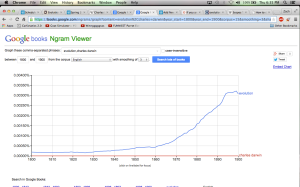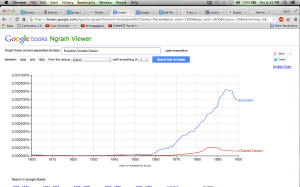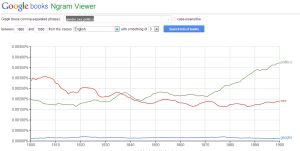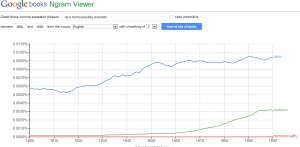We all know Charles Darwin, the man who crafted the theory of evolution, one of the most controversial topics that have shaped modern science. Whether you like it or not he told us that we share a common ancestor with chimpanzees, I hope you fall with the group that thinks it’s cool or really doesn’t care, since chimps are actually quite intelligent and can be capable of sign language (don’t dismiss them as dumb monkeys because maybe in a thousands years they may rule the earth). Evolution has caused a huge rift within the world as creationism was thought to be the reason for our origin. Religion was a big part of everyone’s life and when Charles Darwin published On the Origin of Species in 1859, evolution’s use skyrocketed within the year.
In the Ngrams there is one very interesting trend in both the examples. Capitalization will alter your results drastically. This is especially important for names as “charles darwin” has a low result compared to “Charles Darwin,” even “Evolution” and “evolution” come up with different results.
Even after On the Origin of Species was published, Darwin’s name has not seen too much of an increase in use until about 1880. It has however seen a small upward trend after his second book on evolutionary theory, The Descent of Man, and Selection in Relation to Sex was published in 1871. The biggest increase of the use of his name came after his death on April 19th, 1882.

Evolution however, has seen its usage grow and grow for many decades as scientists, philosophers and other scholars have become interested in the topic and started researching it themselves. It is important to keep in mind that the evolution has many different definitions but its rise seems to be no coincidence however, as from 1859 the graph looks almost like the stock market in the roaring twenties. My comparison isn’t too far fetched as towards 1900, evolution shows a sharp decrease. Maybe discussion of evolution has started to subside, but it wasn’t too long before the Supreme Court of Tennessee will increase usage of the word to denote humans evolving.




